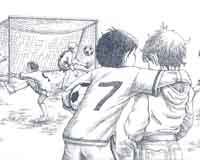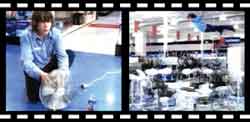
The Project directors acknowledge the vital support and contributions
of many people to this report, including:
•
the very dedicated staff of the Educational Assessment Research
Unit
• Heleen Visser and other staff members of the Ministry of
Education
• members of the Project’s National Advisory Committee
• members of the Project’s Literacy Advisory Panel
• principals and children of the schools where tasks were
trialled
• principals, staff and Board of Trustee members of the 255
schools included in the 2006 sample
• the 2878 children who participated in the assessments and
their parents
• the 96 teachers who administered the assessments to the
children
• the 46 senior tertiary students who assisted with the marking
process
• the 205 teachers who assisted with the marking of tasks
early in 2007.

New
Zealand’s National Education Monitoring Project (NEMP) commenced
in 1993, with the task of assessing and reporting on the achievement
of New Zealand primary school children in all areas of the school
curriculum. Children are assessed at two class levels: year 4 (halfway
through primary education) and year 8 (at the end of primary education).
Different curriculum areas and skills are assessed each year, over
a four-year cycle. The main goal of national monitoring is to provide
detailed information about what children can do so that patterns
of performance can be recognised, successes celebrated, and desirable
changes to educational practices and resources identified and implemented.
Each year, small random samples of children are selected nationally,
then assessed in their own schools by teachers specially seconded
and trained for this work. Task instructions are given orally by
teachers, through video presentations, or in writing. Many of the
assessment tasks involve the children in the use of equipment and
supplies. Their responses are presented orally, by demonstration,
in writing, or through submission of other physical products. Many
of the responses are recorded on videotape for subsequent analysis.
In 2006, the fourth year of the third cycle of national monitoring, two areas were assessed: health and physical education, and the writing, listening and viewing components of the English curriculum.This report presents details and results of the assessments of student skills and knowledge in listening and viewing.
Many of the tasks were used with both year 4 and year 8 students, which allows direct comparisons of the performance of year 4 and 8 students in 2006. Because some of the tasks were used both in 2002 and in 2006, trends in performance across the four-year period can also be examined.
| ASSESSING
LISTENING AND VIEWING |
|
Chapter 2 explains the place of listening and viewing in the New Zealand curriculum and presents the frameworks for listening and viewing. The listening framework has as its central organising theme constructing meaning from oral communications. Seven purposes are specified in the framework, together with a number of understandings, skills and attitudes that students and their teachers are working to develop. The viewing framework has as its theme constructing meaning from visual texts. In other respects it has a parallel structure to the listening framework. |
|

|
Chapter 3 presents results from the tasks that assessed the students’ listening skills. Averaged across 176 task components administered to both year 4 and year 8 students, 14 percent more year 8 than year 4 students succeeded with these components. The trend analyses showed very little change from 2002 to 2006. Averaged across 78 task components attempted by year 4 students in both years, on average one percent more students succeeded in 2006 than in 2002. At year 8 level, with 94 task components included in the analysis, on average two percent more students succeeded in 2006 than in 2002. |
Students generally achieved quite high
performance levels on task
components that involved recalling
and using specific factual information. They were less successful where the task components involved interpretation or inference, such as distinguishing facts from opinions, interpreting messages in a story, or evaluating the merits of opposing arguments. They also had difficulty with puns and figurative language.
| Chapter 4 presents results for the viewing tasks which assessed the students’ capabilities in constructing meaning from visual material. Averaged across 191 task components administered to both year 4 and year 8 students, eight percent more year 8 than year 4 students succeeded with these components. The trend analyses showed a slight downward change for both year 4 and year 8 since 2002. Averaged across 83 task components, there was a loss of less than one percent from 2002 to 2006, with 32 gains and 44 losses. For year 8 students, there was a loss of one percent from 2002 to 2006, with 41 gains and 54 losses across 102 task components. Overall, these slight decreases over the four-year period are not significant. |
|
| Consistent with previous findings in 1998 and 2002, year 4 and year 8 students often achieved quite high performance levels on task components that involved observing, recalling and using specific factual information. They were less successful where the task components involved interpretation or evaluation of visual messages, or of the intentions of the designers of those messages. These latter components usually were handled substantially better by year 8 than year 4 students. |
Chapter 5 reports the results of analyses that compared the performance of different demographic subgroups.
School size, school type (full primary, intermediate, or year 7 to 13 high school) and community size were not important factors predicting achievement on the listening and viewing tasks. These results parallel those from the 2002 and 1998 assessments.
|

|
There were differences by zone (region) for fewer than 12 percent of the listening and viewing tasks at both year levels. At year 4 level only, this represents a change from the 2002 assessments, where South Island students scored higher than Auckland students on 36 percent of listening tasks and 44 percent of viewing tasks. The results from 2006 are similar to the 1998 results, which saw few differences by zone at both year levels. |
There were statistically significant differences in the performance of students from low, medium and high decile schools on 88 percent of the listening tasks at year 4 level (compared to 71 percent in 2002 and 87 percent in 1998) and 75 percent of the listening tasks at year 8 level (compared to 59 percent in 2002 and 78 percent in 1998). Overall, there has been little reduction in disparities of achievement on listening tasks between 1998 and 2006. For the viewing tasks, there were differences on 57 percent of the tasks at year 4 level (compared to 50 percent in 2002 and 100 percent in 1998) and 69 percent of the tasks at year 8 level (compared to 61 percent in 2002 and 86 percent in 1998). The reductions in disparities of achievement on viewing tasks observed between 1998 and 2002 have been maintained in 2006.
Girls averaged slightly higher than boys on listening tasks at both year levels, with a mean effect size at year 4 level of 0.09 (slightly reduced from 0.13 in 2002) and a mean effect size at year 8 level of 0.10 (reduced from 0.19 in 2002). On the viewing tasks, gender differences also favoured girls but were small at both year levels, both in 2006 and earlier in 2002. The mean effect size at year 4 was 0.02 (slightly reduced from 0.05 in 2002), while at year 8 level it was 0.09 (slightly increased from 0.06 in 2002).
Pakeha students averaged higher than Mäori students on the listening tasks, with a large mean effect size of 0.47 for year 4 students (increased from 0.34 in 2002) and a moderate mean effect size of 0.33 for year 8 students (little changed from 0.29 in 2002). On the viewing tasks, Pakeha students scored moderately higher than Mäori students at both year levels. The mean effect size for year 4 students was 0.29 (little changed from 0.32 in 2002), while for year 8 students the mean effect size was 0.30 (little changed from 0.31 in 2002).
Pakeha students averaged substantially higher than Pasifika students on the listening tasks, with a large mean effect size of 0.55 for year 4 students (reduced from 0.71 in 2002) and a similarly large mean effect size of 0.61 for year 8 students (little changed from 0.63 in 2002). On the viewing tasks, Pakeha students scored moderately higher than Pasifika students at year 4 level and more strongly higher at year 8 level. The mean effect size for year 4 students was 0.26 (substantially reduced from 0.43 in 2002), while for year 8 students the mean effect size was 0.40 (reduced from 0.51 in 2002).
Compared to students for whom the predominant language at home was not English, students from homes where English predominated averaged moderately higher on listening tasks (mean effect sizes 0.24 at year 4 level and 0.28 at year 8 level). For viewing tasks, the advantage for students from homes where English predominated was smaller, with small mean effect sizes of 0.14 at both year levels. Comparative effect sizes are not available from the 2002 assessments. |